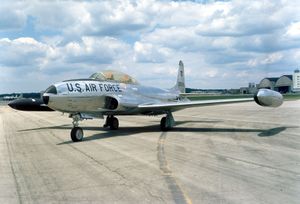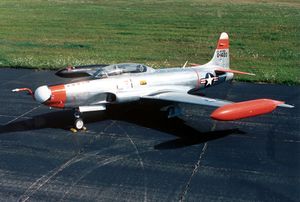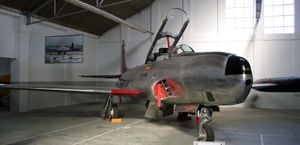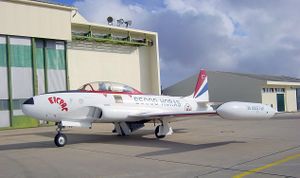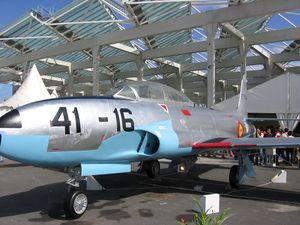PlaneSpottingWorld welcomes all new members! Please gives your ideas at the Terminal.
T-33 Shooting Star
| T-33 Shooting Star | |
|---|---|
| Type | Training aircraft |
| Manufacturer | Lockheed |
| Designed by | Clarence "Kelly" Johnson |
| Maiden flight | 22 March 1948 |
| Primary users | United States Air Force United States Navy |
| Produced | 1948-1959 |
| Number built | 6,557 |
| Developed from | P-80 Shooting Star |
| Variants | T2V/T-1A Seastar CT-133 Silver Star |
The Lockheed T-33 Shooting Star is an American-built jet trainer. It was produced by Lockheed and made its first flight in 1948, piloted by Tony LeVier. The T-33 was developed from the Lockheed P-80/F-80 starting as TP-80C/TF-80C in development, then designated T-33A. It was used by the USN as the intially as TO-2, then TV-2, and after 1962 T-33B. Despite its vintage, the venerable T-33 still remains in service worldwide.
Contents
Design and development
The T-33 was developed from the Lockheed P-80/F-80 by lengthening the fuselage and adding a second seat, instrumentation and flight controls. Initially designated as a variant of the P-80/F-80, the TP-80C/TF-80C.
Design work for the Lockheed P-80 began in 1943 with the first flight on 8 January 1944. Following on the Bell P-59, the P-80 became the first jet fighter to enter full squadron service in the US Army Air Force. As more advanced jets entered service, the F-80 took on another role - training jet pilots. The two-place T-33 jet was designed for training pilots already qualified to fly propeller-driven aircraft. It was developed from the single-seat F-80 fighter by lengthening the fuselage slightly more than three feet to accommodate a second cockpit.
Originally designed the TF-80C, the T-33 made its first flight on 22 March 1948 with US production taking place from 1948 to 1959. The U.S. Navy used the T-33 as a land based trainer starting in 1949 as the TV-2, these were redesignated T-33B in 1962. The Navy operated some ex-USAF P-80Cs as the TO-1, changed to TV-1 about a year later. A carrier capable version of the P-80/T-33 family was subsequently developed by Lockheed, eventually leading to the late 1950s to 1970s T2V-1/T-1A SeaStar. A total of 6,557 Shooting Stars were produced, 5,691 by Lockheed.
Operational service
The two-place T-33 proved to be a suitable advanced trainer and, in addition to its primary use as a trainer, it has been used for such tasks as drone director and target towing, and some T-33s retained two machine guns for gunnery training. In some countries, the T-33 was even employed as a combat aircraft. The RT-33A version, reconnaissance aircraft produced primarily for use by foreign countries, had a camera installed in the nose and additional equipment in the rear cockpit. T-33s continued to fly as currency trainers, drone towing, combat and tactical simulation training, "hack" aircraft, electronic countermeasures and warfare training and test platforms right into the 1980s.
The T-33 has served with over 30 nations, and continues to operate as a trainer in smaller air forces .Canadair built 656 T-33s on licence for service in the Canadian Forces as the CT-133 Silver Star while Kawasaki manufactured 210 in Japan. Other operators included Brazil,Turkey and Thailand which used the T-33 extensively.
In the 1980s, an attempt was made to modify and modernize the T-33 as the Boeing Skyfox, but a lack of orders led to the cancellation of the project. About 70% of the T-33s airframe was retained in the Skyfox, but it was powered by two Garrett TFE731-3A turbofan engines.
Variants
USAF
- T-33A: Two-seat jet trainer aircraft.
- AT-33A: Two-seat attack version of the T-33A.
- DT-33A: This designation was given to a number of T-33As converted into drone directors.
- NT-33A: This designation was given to a number of T-33As converted into special test aircraft.
- QT-33A: This designation was given to number of T-33As converted into target drones.
- RT-33A: Two-seat reconnaissance version of the AT-33A.
- TO-1/TV-1: U.S. Navy designation of P-80C, 50 transferred to USN in 1949 as jet trainers (not technically T-33 Shooting Star)
- TO-2: Two-seat land-based jet training aircraft for the US Navy. It was the US Navy's version of the T-33A. Later redesignated TV-2.
- TV-2KD: This designation was given to number of TV-2s converted into drone directors.
- T-33B redesignation of Navy's TV-2 in 1962.
- DT-33B redesignation of Navy's TV-2D
- TV-2KD redesignation of Navy's TV-2KD
Canada
- CT-133 Silver Star : Two-seat jet trainer for the RCAF.
Operators
- Template:BEL
- Template:BOL
- Template:BRA
- Template:BIR
- Template:CAN
- Template:CHI
- Template:ROC
- Template:COL
- Template:CUB
- Template:DNK
- Template:ECU
- Template:SLV
- Template:FRA
- Template:GER
- Template:GRE
- Template:GUA
- Template:IDN
- Template:IRN
- Template:ITA
- Template:JPN
- Template:LBA
- Template:MEX
- Template:NLD
- Template:NIC
- Template:NOR
- Template:PAK
- Template:PER
- Template:PHI
- Template:POR
- Template:SAU
- Template:SIN
- Template:SKO
- Template:SPA
- Template:THA
- Template:TUR
- Template:USA: US Air Force, US Navy
- Template:URU
- Template:VEN
- Template:YUG
Specifications (T-33A)
General characteristics
- Crew: Two
- Length: 37 ft 9 in (11.2 m)
- Wingspan: 38 ft 10.5 in (11.5 m)
- Height: 11 ft 8 in (3.3 m)
- Empty weight: 8,300 lb (3,775 kg)
- Max takeoff weight: 15,100 lb (6,865 kg)
- Powerplant: 1× Allison J33-A-35 centrifugal compressor turbojet, 5,400 lbf (23 kN)
Performance
- Maximum speed: 600 mph (970 km/h)
- Range: 1,275 miles ferry (2,050 km)
- Service ceiling: 48,000 ft (14,600 m)
Armament
- (AT-33) 2x 0.50 in (12.7 mm) Browning M3 machine guns with 350 rounds per gun
- Up to 2,000 lb (907 kg) of ordnance on two underwing hardpoints. Weapons carried include bombs and rocket pods.
Reference
- Davis, Larry. P-80 Shooting Star. T-33/F-94 in action. Carrollton, Texas: Squadron/Signal Publications, 1980. ISBN 0-89747-099-0.
External links
Related content
Related development
Comparable aircraft
Designation sequence
- Pre-1962 Navy : TV-1 - TV-2 - T2V
- Pre-1962 Navy : TE - TF - TT - TO - TV
- USAAC/USAAF: XT-30 - T-31 - T-32 - T-33 - T-34 - T-35 - T-36 - T-37
Related lists
Airliners and Civil Transports: Vega · Electra · Electra Junior · Super Electra · Lodestar · Constellation · Saturn · L-188 Electra · L-402 · JetStar · L-1011 TriStar
Military Transports : C-64 · C-121 · R6V · C-130 Hercules · C-141 Starlifter · C-5 Galaxy
Fighters: F-22 Raptor · F-35 Lightning II · F-94 Starfire · F-104 Starfighter · F-117 Nighthawk · P-38 Lightning · P-80 Shooting Star · T-33 Shooting Star
Patrol and reconnaissance : Hudson · PV-1 Ventura · PV-2 Harpoon · P-2 Neptune · P-3 Orion · CP-140 Aurora/CP-140A Arcturus · U-2 · SR-71 Blackbird · S-3 Viking
Lists relating to aviation | |
|---|---|
| General | Timeline of aviation · Aircraft · Aircraft manufacturers · Aircraft engines · Aircraft engine manufacturers · Airports · Airlines |
| Military | Air forces · Aircraft weapons · Missiles · Unmanned aerial vehicles (UAVs) · Experimental aircraft |
| Notable incidents and accidents | Military aviation · Airliners · General aviation · Famous aviation-related deaths |
| Records | Flight airspeed record · Flight distance record · Flight altitude record · Flight endurance record · Most produced aircraft |
ja:T-33 (航空機) no:Lockheed T-33 Shooting Star pt:Lockheed T-33
